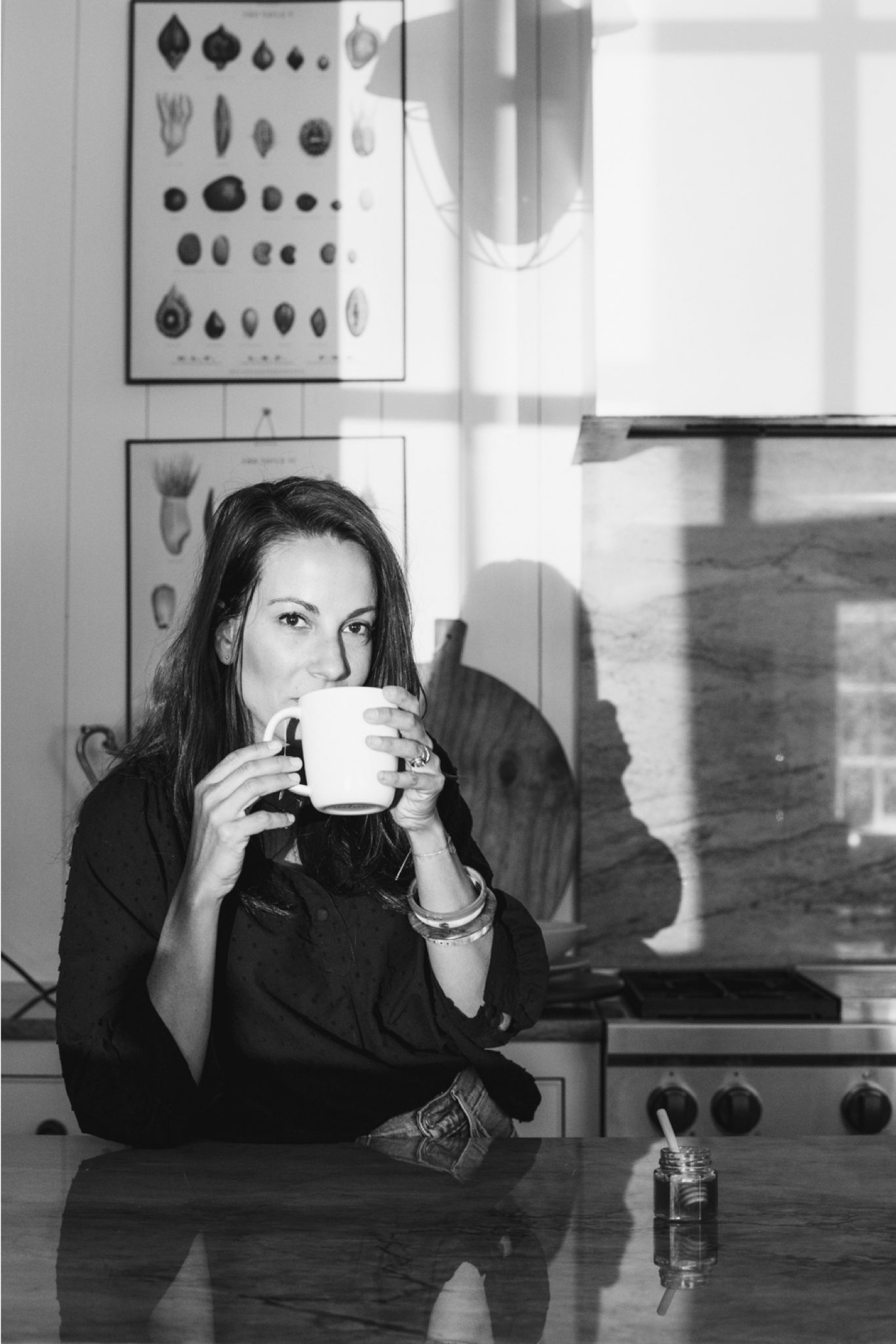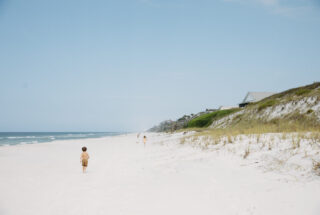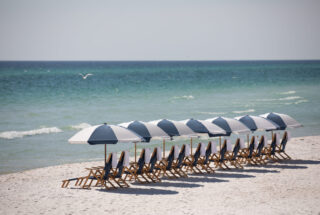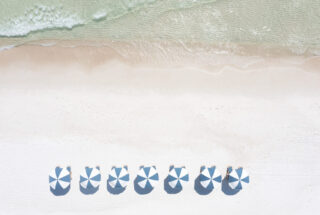

Images by Nicola Hanger
Words by Cassie Condrey
Through my phone screen I see Erika Powell perched in a chair that appears to be in the corner of a screened porch. Behind her, the landscape is plush and fertile and warm. It is the kind of place that, with only a glimpse, you are sure you would like very much to be. My conversation with Erika centered on design and what it’s like for her firm Urban Grace Interiors to design at Alys Beach, but we might have had a dozen other conversations that sprung from this one. Her line of textiles, her love of painting, her identical twin, homeschooling her children through a pandemic, the growth of 30A and what she’s seen from her front row seat, the island escape she and her husband have renovated in the Keys.
She is not someone who has put herself in a box. Her life is full. She works hard and gives a lot of herself to her work, but there is a lot to give. And then she comes home. You sense the sigh of relief in her when she talks of the home she shares with her husband and two daughters and the home they now vacation at in the Keys. I learn in our conversation that the landscaping I see behind her, she did herself. A quick search and photos of her home reveal a layered warmth, a sense of place and a refuge. Water, she says, brings her peace. What she has created for herself, she creates for her clients. Be at home here. Take a breath here.
CC: Tell us about where you grew up—your childhood, early interests, memories—and how you got to where you are now. EP: I kind of grew up all over. I’m an identical twin. We were born in Virginia and then my dad’s job took us to Chicago then to Atlanta and then back to Chicago. Those were my elementary school years. So we moved quite a bit. When we finished elementary school, we moved to Louisville, Kentucky, and I really claim Louisville as home. Middle and high school—all of my memories are there. My dad had a corporate job, but my parents also did real estate. They would flip houses—buy old houses and fix them up. Most of my childhood weekends were spent scraping paint and working on millwork and cast-iron bathtubs. Not your average childhood. I always swore that I would avoid that type of career at all costs, and then here I am. My sister and I decided that we didn’t want to go to a state school in Kentucky like everybody else was doing and so we went to Auburn. At that point in time there was the Academic Common Market where if your state school didn’t offer your major you could go to another state school for in-state tuition rates. So I started out in International Business at Auburn. I took two years of that and thought okay, I really want to do interior design. So I transferred majors and graduated interior design. My twin sister got done in three and a half years, got married and moved off. Growing up, while I was in high school and in college, we always vacationed down here at 30A and spent quite a bit of time in Seaside and WaterColor. So when I graduated I thought, well that’s probably a pretty good place to be looking for a job and so right out of school, in 2003, I came straight down here and took a job working for an interior designer. And here I am, never left.
CC: I wish I had your childhood experiences of being around old houses and working on them. My husband and I love old homes and are about to begin another project restoring an 1832 house, and it’s experience that makes you know how to do things. Very cool that you got that so young. Do you use that in your day-to-day now? EP: Yes, probably so. But my husband and I just bought a house in Islamorada, a 1962 midcentury modern house. Plaster walls and concrete block and all of that. We’ve renovated the whole thing ourselves and painted and tore things out. We make a good team because he can do all of the technical stuff—he’s an engineer—and I know what I want it to look like. CC: Did you from an early age realize you were drawn to design? EP: I think so. My mom always dabbled in design work and she’s the one responsible for designing these houses that they would buy and renovate. Our own house in Louisville is 150 years old and she did all of that, additions and bathroom remodels, and so I lived that life, really, as a child. I think I was just in denial when I started school—like oh I don’t want to do what my parents have done. My dad was a creative marketing executive growing up and so they both had this creative background and passion, but I fought it thinking I was going to pave my own way, but it’s kind of innate, you know, and I just couldn’t fight it anymore. CC: I think that’s part of the path of becoming an adult. You fight it as long as you can and then you accept it and bring yourself into it. EP: Exactly.

CC: You’ve made a home and a life for yourself in Florida. What is about that particular place that you love? EP: Oh my gosh. I just love it. I did my internship in college in New York and I love cities and I love visiting cities, but I am not a city person. I need water and grass and a garden. That’s just who I am. We live on a bayou here, on the bay side. 30A and the beach is all on the south side and we’re on the north side where it’s quiet. I can be in Seaside quickly—as the crow flies, Seaside is three miles from my house, south—but we’re back here where it’s quiet. We can be in all of that mix if we want to be, but it’s so nice to retreat back here. Get on the boat and go out for sunset, not fight the traffic or crowd. CC: That sounds ideal. EP: It is nice. I think because I lived in big cities growing up, when I first got here, I missed city life—museums and history and things like that. But what I lost in terms of what a bigger, older city has to offer, I gained in nature and a laid back lifestyle. I wouldn't trade that for the world. Every move has compromise. Thinking about my childhood and city life, it’s very different than how I’m raising my girls, but it’s pretty magical. We go on the boat every afternoon and are out in nature. CC: We live on a lake and it’s the same. It adds a whole new dimension to your life when you can go get on the water. EP: For sure, and once you’ve lived on the water, I don’t know if I could give it up. It’s like zen. We get out on the water to relax. CC: I’m sure your work is very busy so it’s probably so nice to have that refuge. EP: Oh my gosh, yes.
CC: What does home mean to you and what makes a place feel like home? EP: Home is the most important thing to me. It should be for everyone, really. In my design work too, it’s such an honor to be included in somebody’s design process. To be able to make their home right for them. For me, it’s everything. It’s where I recharge and rest and love on my family and teach my girls and talk to my husband and just unwind. I can be myself completely. My place of refuge. CC: That’s beautiful. What makes it feel like that? Is it the people? I’m sure with your line of work you also need an aesthetic that feels right for you. EP: I think for me here it’s just a coziness. It’s funny because my personal aesthetic and my home aesthetic is very cozy and warm and we’re talking about designing Alys Beach projects which are very fresh and bright and simple. Even my office is very white and very serene. Kind of a mess right now but… I think when I come home I need to feel this sense of cozy warmth, you know. For me it’s the people, too. Obviously we could lose all of this tomorrow and be okay because we have our family. But as far as the design goes, it’s just a place that feels inviting.
CC: You get to experience a unique, intimate connection to another person through your work. I feel like the people who are really good at what you do also have an intuitive sense about people and a warmth. I guess, what is your process of getting to know the person you’re designing for? EP: We were talking about this last week. The designer-client relationship, by the end of it, and usually these are 2-3 year projects, sometimes 4, depending on the size of the project and how early we get involved, but by the end of it we know everything about our clients. How they live, how they brush their teeth, do they take a bath together and need a two-person shower. We get into these really intimate things very early on because it’s their home, where they relax and recharge. It’s really an honor to be invited into somebody’s world that intimately. There’s not really that many relationships where you get to know somebody and how they are at home so it’s really fun. Early on our initial inquiry process is, “what’s your project scope, what’s the size, what’s the inspiration?” We look at that and then once we’re under contract, we really get deeper into the inspiration images, “do you like slipcovers, do you like upholstery, do you like seagrass,” all those fine details. A lot of times the clients I find can’t see a common thread in their inspirations they give us but my team and I can. So we’re like “see what you like here?” Which is fun. It’s kind of like taking all these pieces and putting a puzzle together of what they want. I love it.
CC: Tell me about Alys Beach and what it’s like to design a home here. EP: Oh it’s fun. You talk about a blank slate, it really is a blank slate. You start every project with this white canvas. A lot of the times the house remains white on the inside and I think the most intriguing and fun part of designing there is just showing restraint. As a designer it’s hard to do. You've seen all these things that would be good in the house, but really fine-tuning what’s important, what’s necessary and keeping it restrained. I think that’s the hardest thing in design, personally, for me to do is to keep it narrowed down and simple and understated because that’s what the architecture demands. So, I think it’s been the most fun part of working there. A lot of designers tend to over decorate or overdo it and especially when you have a white canvas to work with it’s easy to go crazy. But showing the restraint is as hard as going all out. CC: Do you know how many homes you’ve designed here? EP: Between twelve and fifteen maybe. CC: Do they all look totally different? EP: They all probably have a common thread. We want our fingerprint to be on it, we want people to know that it’s our work, but we also want it to be unique to the client. But also right for Alys Beach, and so they probably have some common threads running through them— seagrass, slipcovers, neutrals.

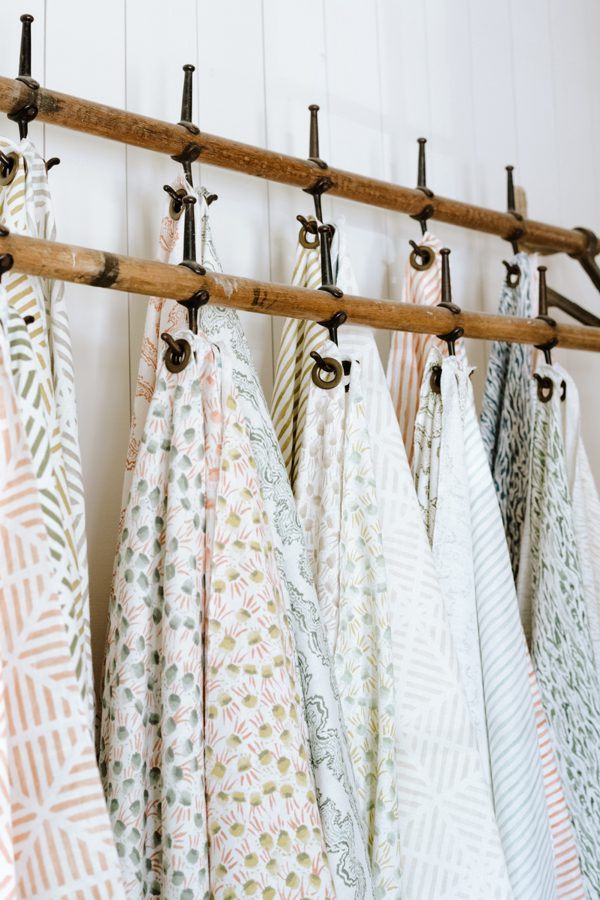
CC: Thinking of your fingerprint… How do you boil that down? EP: One thing that bugs me, that’s just not me, are things that are too precious. I don’t know what the opposite of that is. Maybe understated. I want things to be elegant but I want them to be understated and casual. I don’t want somebody to walk into a house and feel like they can’t sit down. Nothing too precious. CC: Put their feet on the coffee table… EP: Exactly. Even in Alys Beach. It’s a beach house. People are going to come in with sandy feet and they’ve been at the pool and nothing should be so fancy that you can’t sit down and kick your feet up.
CC: Can you tell me where you started in your design business and how did you break out on your own? I know you have your own textiles line now. EP: When I graduated, I moved down here for a job with Susan Massey. I worked for her for a little while and then I went to work for an architect, Tom Christ. Between those two, I think I got a really good basis in local design with Susan and the architecture side with Tom. I was doing tons of CAD, tons of elevations, so when I went on my own in 2004 or 2005, I felt I had the best of the local training that I could, and at that point in time Alys wasn’t even off the ground. I was doing a lot of work in WaterColor and Seaside and the market was booming. I did a lot of spec houses which was really fun because I just got to do whatever I wanted to do which is really rare for somebody at my age with a lack of experience. I got to know a builder really well that was doing a bunch of specs in WaterColor and I think I had three kitchens featured in Coastal Living in maybe 2008 or 2009 and then it started booming from there. Every year the business grew and continued to grow. Even during the recession and when we had hurricanes and shark attacks that were hindering local economy, I had a blog and started advertising that I would travel and would take out-of-town clients because it had slowed down around here and I just continued to bust my tail. I worked so hard. I had just had my daughter Sloane in 2009 and continued to take on out-of-town work. It allowed me to do projects in other cities, like Memphis and Atlanta, places with historic architecture unlike what we have here. It was different, interesting, and fun, but then about five years ago everything began to shift again. Alys Beach was coming up and I was crazy busy locally and so we cut back on out of town work unless it’s a really good project. I have two kids and so traveling is hard. If I’m going to travel, I want to travel for fun, not for work. It takes so much to coordinate leaving my children.
CC: Well, speaking of travel, where do you like to go for fun? EP: Islamorada. We have a little tiny vacation house there. It’s 900 square feet and that’s where we go for fun. We’re going next weekend, I can’t wait. It’s the key just south of Key Largo. CC: I believe that creativity begets creativity. So I’m curious about how you grow yourself creatively? Are there other things you do like drawing or reading or cooking that help you to stay connected with the creative part of yourself? EP: I do, I cook every night. Gardening used to be a really big thing for me, but lately work has been really demanding, it’s been tough. I started a textiles line three or four years ago now and that was a really fun side business to start and it’s grown and it’s been challenging and great and all the things. But I do a lot of painting-I paint all of the patterns myself. 2020 kind of did me in, I’m just going to be honest. Running multiple businesses and kids at home. I wasn’t very creative outside of work. Which is kind of sad to admit. My daughters and I spend the month of July in Islamorada and I paint every day at the kitchen table there and I’m looking very forward to that and getting back into it. Because last July I was in panic mode, you know, wondering what was going to happen to the world.
CC: For good reason. How do you start your day? Even through travels and work, do you have any type of daily ritual that you stick with no matter where you are? EP: I gave up coffee in May of last year, but I drink tea and so I usually get my tea and come out here to my porch in this chair in the corner, overlooking my yard. I tiptoe because I don’t want to wake my children, because Mama needs some solitude and I have not been alone since March of last year. So I tiptoe because if I wake somebody up I’m going to cry. I just need an hour. I get up very early and need that hour alone. I drink my tea until they wake up and then start getting breakfast ready. CC: What does a day of leisure look like for you? Where do you go? What cocktail are you drinking? What are you eating? EP: My cocktail of choice in the summer is a grapefruit basil martini. It’s so good. It’s just fresh squeezed grapefruit and basil which you smack to get the aromatics and then mix it with vodka, or gin, Hendricks gin is good too. A day of leisure would probably be a day on the water-either at the beach at Grayton with my family or on the boat in the bay. Or just sitting on my patio and reading. Nothing majorly exciting, just low key. CC: What else inspires you? What in your day-to-day life gives you energy? EP: Being outside. Going for a walk. It’s crazy how much going for a walk will clear my mind. Being alone. As a mom and employer, I can remember one time a business owner on Instagram said something about decision fatigue. Like I had to make so many decisions today… I kind of feel like that. There is something about getting away and not having to answer questions and to be alone. It’s really good for me. So going for walks or sitting on the dock by myself. That hour in the morning is so critical just to recharge. Also, getting my fill of cities, museums and the arts, when I travel.
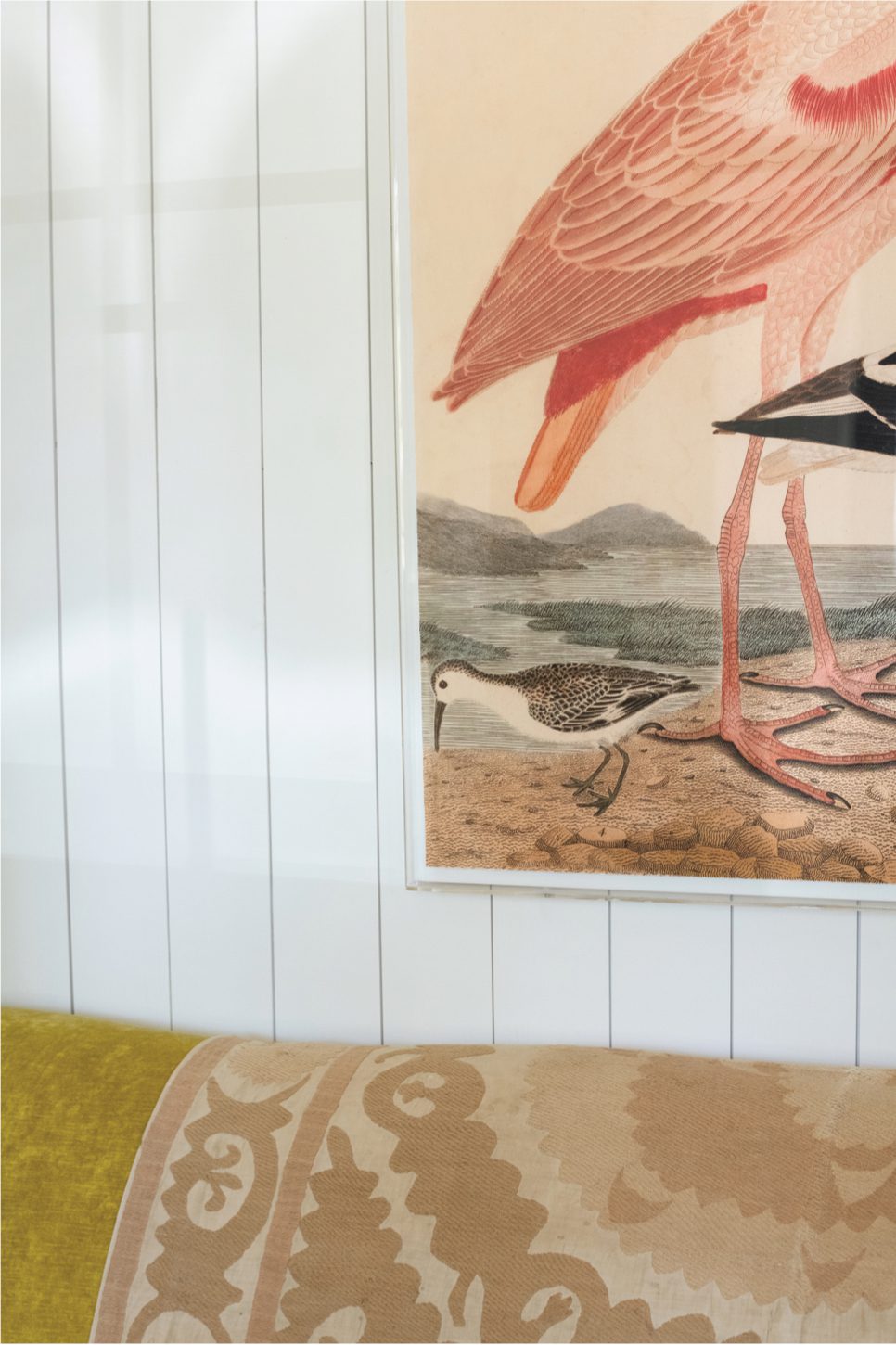
CC: I have to have solitude also. If someone gave you a compliment as a designer, what would be the ultimate for you? EP: Oh my goodness. This is not design-related, but I have a friend years ago who came to my house and wanted to know who my landscape architect was and I said, I don’t have one. I did this myself. What’s the equivalent of that for interiors? I’m working on a restaurant at Rosemary for a good friend of mine. I designed the 2012 Coastal Living Idea House and this guy was the builder, and he’s building this restaurant and says, “Do what you want to do, Erika, do what you think this area needs.” He’s trusting me without any hesitation or questioning and I think the ultimate compliment for a designer is for a client to come to you and say just surprise me. Like I love your style, here’s what I like, but surprise me. We just did a presentation for an Alys Beach client and we were talking about it at the office. They didn’t give us any inspiration images at all. They said we saw everything on your website, just do that. We love it. Which is really nice. CC: I can see how that would indeed be the ultimate. EP: We always joke that we can’t archive anything because our clients never go away. It’s kind of the truth. They continue to add to the design as the years go on, or they hire us when they build their next house. We’ve had clients we’ve done four or five projects with. That also means a lot.
CC: Where in the process do you come in? Are you with the architect from the beginning? EP: It really depends. Ideally we are. We would love to be involved early because then we can help with cabinet elevations and appliances and lighting and all of that. I break the design process into two phases-one being construction and the second being furnishings. Alys Beach sells a lot of construction where they have their package of selections where people can pick through so we don’t do a ton of that with those but for others we do a lot of construction selections-tile, flooring, appliances, lighting all of that. The sooner we get involved, the more accurate their drawings are when they go out for bid. So they don’t have as many change orders, they know what to expect, the builder knows what to expect, and it just makes it a lot more seamless. CC: Do you have a favorite project over the years? Or images that have stayed with you? EP: I do love the bunk room at that Coastal Living show house. That’s my favorite bunk room. There are things I like about every project. I could pick and choose rooms from all the different houses. They’re all my babies, I love them all. CC: This has been a real pleasure. Thank you so much for sharing your story. EP: Thank you. Loved getting to know you.
